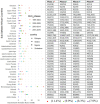Spatiotemporal models with confounding effects: application on under-five mortality across four sub-Saharan African countries
- PMID: 39911222
- PMCID: PMC11795394
- DOI: 10.3389/fpubh.2025.1408680
Spatiotemporal models with confounding effects: application on under-five mortality across four sub-Saharan African countries
Abstract
Background: Different strategies have been developed to minimize under-five mortality (U5M) in sub-Saharan African (sSA) countries; however, it is still a major health concern for children in the region. Spatiotemporal modeling is important for areal data collected over time. However, when the number of time points and spatial areas is large and the areas are disconnected, fitting the model becomes computationally complex because of the high number of required parameters to be estimated. Therefore, the main aim of this study is to adopt a spatiotemporal dynamic model that includes the confounding effects between time, space, and their interactions with fixed covariates, with a special emphasis on U5M across disconnected sSA countries.
Method: We used nationally publicly representative Demographic and Health Survey (DHS) data for the period from 2000 to 2020. Bayesian spatiotemporal hierarchical modeling with an integrated nested Laplace approximation (INLA) program was used to model the spatiotemporal distribution of U5M among children across 37 districts located in four disconnected sSA regions: Ethiopia, Nigeria, Zimbabwe, and Ghana.
Results: A total of 170,356 under-five children from 37 districts were considered, and 15,467 died before the age of five. The relative risk of U5M in the first DHS was 2.02, which sharply decreased to 0.5 in the recent phase. The proportion of improved access to water, sanitation, clean fuel use, urbanization, and access to health facilities in the district had a significant negative association with U5M. The higher the proportion of these covariates, the lower is the prevalence of childhood mortality.
Conclusion: This study revealed evidence of strong spatial, temporal, and interaction effects that influence under-five mortality risk across districts. Improving the women's literacy index, access to improved water, the use of clean fuel, and the wealth index are associated with an improvement in the risk of mortality among under-five children across the districts. Districts in Nigeria and Ethiopia have the highest risk of U5M; hence, districts in these countries require special attention.
Keywords: confounding; space-time interactions; spatial random effects; spatiotemporal models; variance partitioning.
Copyright © 2025 Fenta, Chen, Zewotir and Rad.
Conflict of interest statement
The authors declare that the research was conducted in the absence of any commercial or financial relationships that could be construed as a potential conflict of interest.
Figures






Similar articles
-
Socioeconomic factors contributing to under-five mortality in sub-Saharan Africa: a decomposition analysis.BMC Public Health. 2019 Jun 14;19(1):760. doi: 10.1186/s12889-019-7111-8. BMC Public Health. 2019. PMID: 31200681 Free PMC article.
-
Under-five mortality and its associated factors in sub-Saharan Africa: a multilevel analysis of recent demographic and health surveys data based on Bayesian approach.BMC Pediatr. 2025 Feb 8;25(1):103. doi: 10.1186/s12887-025-05454-6. BMC Pediatr. 2025. PMID: 39923019 Free PMC article.
-
Exclusive Breastfeeding, Child Mortality, and Economic Cost in Sub-Saharan Africa.Pediatrics. 2021 Mar;147(3):e2020030643. doi: 10.1542/peds.2020-030643. Pediatrics. 2021. PMID: 33622796
-
Women's empowerment as a determinant of neonatal mortality in Sub-Saharan Africa: a narrative review focused on Nigeria.Glob Health Action. 2024 Dec 31;17(1):2394256. doi: 10.1080/16549716.2024.2394256. Epub 2024 Aug 28. Glob Health Action. 2024. PMID: 39193753 Free PMC article. Review.
-
Impact of the HIV epidemic on mortality in sub-Saharan Africa: evidence from national surveys and censuses.AIDS. 1998;12 Suppl 1:S15-27. AIDS. 1998. PMID: 9677186 Review.
References
-
- Wang H, Bhutta ZA, Coates MM, Coggeshall M, Dandona L, Diallo K, et al. . Global, regional, national, and selected subnational levels of stillbirths, neonatal, infant, and under-5 mortality, 1980–2015: a systematic analysis for the global burden of disease study 2015. Lancet. (2016) 388:1725–74. doi: 10.1016/S0140-6736(16)31575-6, PMID: - DOI - PMC - PubMed
-
- MacFeely S. Measuring the sustainable development goals: what does it mean for Ireland? Administration. (2017) 65:41–71. doi: 10.1515/admin-2017-0033 - DOI
-
- Kim EM. Gender and the sustainable development goals. Glob Soc Policy. (2017) 17:239–44. doi: 10.1177/1468018117703444 - DOI
MeSH terms
LinkOut - more resources
Full Text Sources
Research Materials

